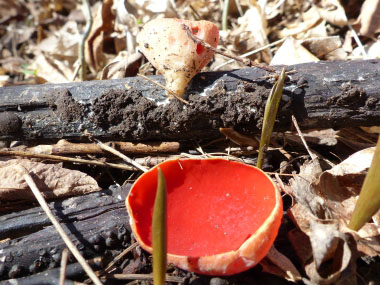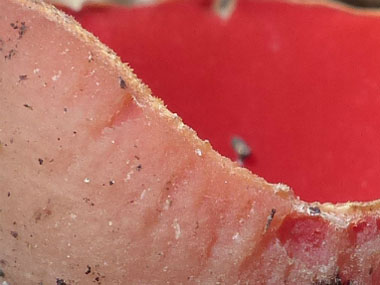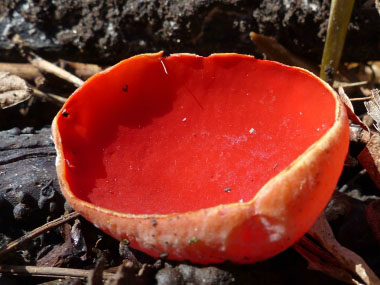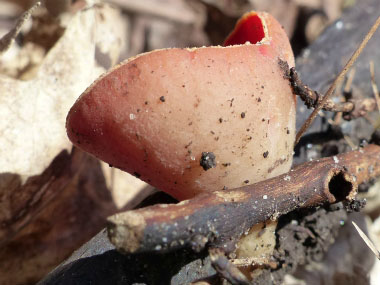






Do not eat any fungi that has not been properly identified by a qualified professional, some are DEADLY when ingested. All edible wild fungi MUST be cooked.
Scarlet cup is a species of fungus in the family Sarcoscyphaceae of the order Pezizales. There is a similar species, Sacoscypha coccinea; both are edible. This is one of the very few mushrooms that can grow in below freezing conditions.
Type
Distinguishing Features
The irregularly shaped cups have a smooth, bright red hymenial (fertile) inner surface and a felted outer surface.The outer (infertile) surface is paler than the inside, sometimes pinkish but often with an ochre tinge. It is covered in tiny hairs. The edges of young cups are often slightly incurved. The cups become wrinkled with maturity, especially near the centre.
Height
The overall height of this mushroom is about 3 cm. It has a short stipe or stem, often buried in moss or leaf litter. The stem is the same colour as the outer surface of the cup or somewhat paler.
Habitat
Scarlet cups are decomposers of dead wood, particularly hawthorn, beech, hazel, willow and elm. They tend to appear on decaying sticks and branches particularly in damp areas of a woodland floor. Sarcoscypha austriaca grows primarily on the eastern side of Canada and the U.S. Sacoscypha coccinea grows on the west side of Canada and the U.S. Both species are found in many parts of the world, including Europe, Asia, Africa, South America and Australia.
Spore Print
White spore print. They make a tiny puffing sound when they release their spores into the air. Microscopic tubes called asci release the spores from the upper 'cup' of the mushroom.
Season
Late winter into early spring.
Gills
No gills.
Edibility
Scarlet cups have a subtle earthy and mushroomy flavour with a slightly woody texture. They can be gently pan fried in a little butter or used in a stew. If overcooked, they lose their flavour. In very small quantities, these can be consumed raw.
Other Name
Moss Cup.
Recipes
To support our efforts please browse our store (books with medicinal info, etc.).
Winter Survival Food Handbook

PDF Plant Magazines
Types of Wild Food
Geographic Zones Seasons
Disclaimer
EdibleWildFood.com is informational in nature. While we strive to be 100% accurate, it is solely up to the reader to ensure proper plant identification. Some wild plants are poisonous or can have serious adverse health effects.
We are not health professionals, medical doctors, nor are we nutritionists. It is up to the reader to verify nutritional information and health benefits with qualified professionals for all edible plants listed in this web site. Please click here for more information.
Why Edible Wild Food?
- Food costs are rising
- Free, wild food is readily abundant
- Wild food adds nutrition to your diet
- Wild food can help treat various medical conditions





